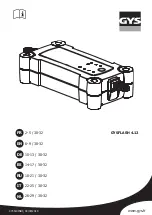
IMPORTANT
154)
LDW has its performance limitations.
Do not over-rely on the system.
155)
LDW is not designed to lessen risks
associated with not looking ahead carefully
(attention drawn to something on the side,
absentmindedness, etc.) or poor visibility
caused by bad weather etc. Keep steering
your vehicle correctly and drive safely.
156)
The system may not be able to detect
the lane correctly in the following
conditions. If required, set the LDW switch
to “OFF.”: when driving on a road whose
lane markings (white or yellow) are worn
out or smeared with dirt to an extent not
recognizable by the system; when lane
markings are vague, typically during a drive
in the rain, snow or fog, or when running
against the sun; when the vehicle is moving
in a place where lane markings are
interrupted, such as a toll booth entrance
and motorway junction; when running on a
road portion with incompletely removed old
lane markings, shadows, lingering snow,
truck-like puddles mistakable for lane
markings (especially after the rain when
road surface is reflecting light) or similar
confusing factors; when running in a lane
other than the cruising lane and passing
lane; when running beside a closed lane
section or in a provisional lane in a traffic
work zone; when running in an extremely
narrow lane; when the following distance
between your vehicle and a vehicle in front
becomes extremely reduced (especially
when a marking is hidden by a vehicle in
front this is running too close to the
marking); when entering a junction or other
point of road where lanes are laid out
complicatedly;
when passing a road section where the
number of lanes increases/decreases or
multiple lanes are crossing each other;
when the lane is marked by double or
otherwise special lines; when driving on a
winding or rough road; when driving on a
slippery road covered by rain water, snow,
ice, etc.; when passing through a place
where the brightness suddenly changes,
like the inlet or outlet of a tunnel; when
turning steep curves; when the road
surface is reflecting the light shining from
the direction opposite to the running
direction; vehicle largely lurches when it is
running over steps or other irregularities of
the road surface; when the headlamp
illumination is inadequate because of
contaminated or deteriorated lenses or
improperly aimed headlamps; when the
vehicle is leaning much to one side due to
heavy luggage on it or improperly adjusted
tyre pressures; when oncoming vehicles’
headlamps shine the LDW camera; when
the vehicle is equipped with nonstandard
tyres (including excessively worn tyres and
temporary spare tyre), uses snow traction
device (tyre chains), or has nonspecified
components such as a modified
suspension; when the windscreen is
covered with rain water, snow, dust, etc.
198
ST
AR
TING
AND
DRIVING
Summary of Contents for Fullback Club cab
Page 1: ...O W N E R H A N D B O O K F I A T F U L L B A C K...
Page 2: ......
Page 10: ......
Page 278: ...VEHICLE DIMENSIONS Club Cab 475 AH5101927 276 TECHNICAL SPECIFICATIONS...
Page 280: ...Double Cab 476 AH5102328 278 TECHNICAL SPECIFICATIONS...
Page 282: ...Single Cab 477 AH5101914 280 TECHNICAL SPECIFICATIONS...
Page 300: ......
Page 301: ......
Page 303: ...NOTE...
Page 304: ......
Page 305: ......
Page 306: ......
Page 307: ......
Page 308: ......
















































